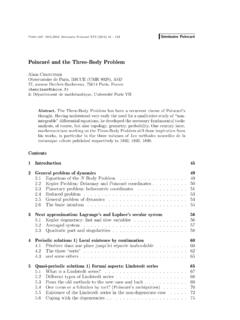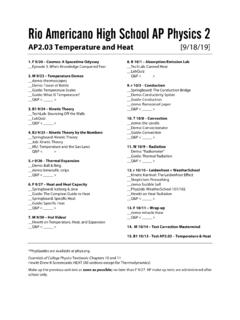Transcription of Time and Relativity - Bourbaphy
1 S eminaire Poincar e XVLe Temps(2010) 1 15S eminaire Poincar eTime and RelativityThibaultDamourInstitut des Hautes Etudes ScientifiquesLe Bois-Marie35, route de Chartres91440 Bures-sur-Yvette, France1 IntroductionTime has many facets, related to most fields of human endeavour, and to manyseparate fields of science : Metaphysics : Heraclitus Panta rei ( everything flows ) ; Zeno s arrow,Leibniz s relational time , Kant s ideality of time ,.. Spirituality : samsara, maya, sunyata, brahmanda (cosmic egg), orphism, berei-shit (book of genesis), eternal return through ekpyrosis, death and resurrection,eternity.
2 Psychology : awareness, flow of consciousness,.. Literature : from Virgil s fugit irreparabile tempus to Proust sIn Searchof Lost time . Music : rhythm, tempo, frequency,.. Historical studies : from Herodotus to Fernand Braudel. Technology : from Sun dials to LED watches. Biology : circadian cycles, aging, programmed cell-death, evolution of species,mitochondrial DNA mutation rate,.. Sociology : working hours, summer time ,.. Probability Theory : Bayesian inference, stochastic differential equations, Mar-kov processes, Kolmogorov-Chaitin complexity,.. Astronomy : day, month, year, celestial mechanics, the origin of the solar sys-tem, chaos.
3 Metrology : atomic clocks, lasers, frequency comparisons,.. Thermodynamics : irreversibility, the Second Law (dS/dt 0),.. Statistical Physics : Boltzmann s equation, Boltzmann sH-theorem,fluctuation-dissipation, Onsager s relations,.. Chemistry:chaoticchemicalreactions,Belou sov-Zhabotinsky,self-organisation,.. Hydrodynamics : Navier-Stokes, viscosity,.. Information Theory : from Brillouin and Szilard to Shannon, Landauer DamourS eminaire Poincar e Electromagnetism : retarded potentials versus advanced ones, radiation, theEinstein-Ritz debate, Wheeler-Feynman,.. Classical Dynamics : Liouville s theorem, periodic systems, quasi-periodic mo-tions, Poincar e recurrences, Lyapunov exponents, chaos, strange attractors.
4 Geology :.. Paleontology :.. Archeology :.. Special Relativity : time dilation, twin paradox, light-cone, Poincar e-Minkowskispacetime geometry,.. General Relativity : gravitational redshift, GPS, warped spacetime, black holes,worm-holes, time travel, closed time -like curves,.. Astrophysics : Doppler effect, gravitational redshift, pulsar timing,.. Cosmology : big bang, expansion of the universe, big crunch, spacelike singu-larities, inflation, eternal inflation,.. Quantum Theory : collapse of the wave function , the measurement issue, thetime-energy uncertainty relation, the Zeno effect,.. Nuclear Physics : nuclear decay, radioactive isotope dating.
5 Atomic Physics : stationary states, quantum transitions, lifetime of unstablestates, Ramsey transitions,.. Quantum Field Theory : St uckelberg-Feynman propagators, Wick rotation,CPT,.. Quantum Gravity : spacetime foam, (de-)emergence of space time at spacelikesingularities, gauge-gravity duality, holography,..This (certainly incomplete) list illustrates the all pervading significance of theconcept of time . The present contribution will focus only on a few aspects of time ,namely those relating its apparent fundamental irreversibility ( Second Law ) toEinstein s revolutionary ideas about Space, time and Matter, and their importin current developments in physics and cosmology.
6 Before coming to grips withthese issues, we shall set the stage by recalling the common conception of time (which was enshrined in Newton sPrincipia), as well as the ground-breaking ideasintroduced by Boltzmann in 1897. Our treatment will be rather brief and interested reader is referred to the books of Paul Davies [1], Brian Green [2],Alex Vilenkin [3] and Sean Carroll [4] for more complete discussions, and referencesto the huge literature on The common conception of TimeIn an often quoted sentence of hisConfessions, Saint Augustine wrote : Whatis time ? If no one asks me, I know. If I wish to explain it to one that asketh, I knownot.
7 However, when pressed to answer the question what is time ? , it seems likelythat the most common answer would roughly be that time is something exteriorto the material universe around us, that passes , or flows , thereby creating ourperception of reality as a now , as well as inexorably dragging this perceptionfrom the past to the future. I do not know for how long this conception of timeVol. XVLe Temps, 2010 time and Relativity3has been commonly held by human beings (nor do I know whether other animalsshare it). Among the ancient Greeks, it seems that, with the important exceptionof Parmenides and his school, the Heraclitean view of a flow of time (common tous and the universe) was considered as the standard one.
8 Jumping to more recenttimes, it seems that mechanical clocks appeared in European convents near the endof the thirteenth century. [They were used to indicate the passing of time to themonks, whose daily prayer and work schedules had to be strictly regulated.]Later, mechanical clocks became part of the everyday life of ordinary citizens,through the construction of clock towers, notably on cathedrals. Their presence inthe city contributed to imposing the conception of a universal time , before the basicscientific advances of the seventeenth century. We have in mind here Galileo (whonoticed the isochronism of small pendulum oscillations, and introduced time in thedynamical description of reality), Huyghens (isochronism of a cycloidal pendulum),and Newton.
9 Let us recall how Newton describes his conceptions of time in the scho-lium to the Definitions at the beginning of his monumental Philosophiae NaturalisPrincipia Mathematica (1687) [5] : Hitherto I have laid down the definitions of such words as are less known, andexplained the sense in which I would have them to be understood in the followingdiscourse. I do not define time , space, place, and motion, as being well known to I must observe, that the common people conceive those quantities under noother notions but from the relation they bear to sensible objects. And thence arisecertain prejudices, for the removing of which it will be convenient to distinguishthem into absolute and relative, true and apparent, mathematical and Absolute, true, and mathematical time , of itself, and from its own nature, flowsequably without relation to anything external, and by another name is called dura-tion : relative, apparent, and common time is some sensible and external (whetheraccurate or unequable) measure of duration by the means of motion, which is com-monly used instead of true time .
10 Such as an hour, a month, a Absolute space, in its own nature, without relation to anything external, remainsalways similar and immovable. Relative space is some movable dimension or measureof the absolute spaces, which our senses determine by its position to bodies ; [..] .The Newtonian concept of absolute time was developed at a time when long-case clocks were used in private homes, and when people started to carry pocketwatches. [It seems that Blaise Pascal (1623-1662) was the first to attach his pocketwatch to his wrist.] Since that time the conjunction of the tick-tock of public orindividual clocks and watches, and of the successful development of the Newtoniandescription of reality (from celestial mechanics to industrial devices) has hamme-red the common conception of time , recalled above, deeply into the minds of Boltzmann and the first time revolutionThe common (and Newtonian)




